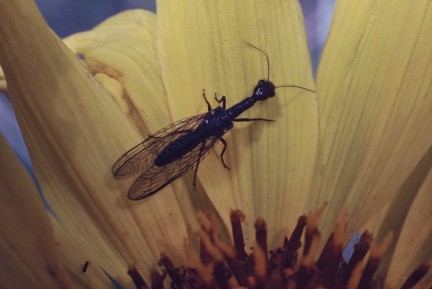 Order
RAPHIDIOPTERA (Snakeflies)
Order
RAPHIDIOPTERA (Snakeflies)Raphidiidae, Agulla sp., photo by M.B. Cooke & R.A. Cannings (Fig. 4)
 Order
RAPHIDIOPTERA (Snakeflies)
Order
RAPHIDIOPTERA (Snakeflies)
Raphidiidae, Agulla
sp., photo by M.B. Cooke & R.A. Cannings (Fig. 4)
Introduction
Raphidioptera: from the Greek raphid = needle, and ptera = wings.
Small to medium sized, elongate and fragile insects. Head prognathous with large eyes and biting, mandibulate mouthparts. The antennae are long, slender and filiform, and the head may or may not possess ocelli. The prothorax is very characteristic, being slender, cylindrical and neck-like, being as long as or longer than the length of the pterothorax. This gives these insects a rather snake-like appearance, hence the common name.
The forewings and hindwings are similar, lack an extensive anal fan, and are held roof-like over the abdomen when at rest. The forewings possess a distinct pterostigma. The legs are not specialized, and have a 5-segmented tarsus. Cerci are absent, and females possess a long, slender, exserted ovipositor.
Adults can be found in early spring, and fly only a short distance. They feed actively on small bodied insects, including their own congeners if put together. They are also reported to take nectar.
Abdominal vibration is usually a component of the courtship behaviour. Females use the ovipositor to deposit eggs singly or in small batches in bark, crevices, in debris or under the body of mature scale insects. The elongate larvae are terrestrial, with mandibulate, chewing mouthparts. They live in bark crevices, or in areas with dead leaves or debris. They are aggressive predators, feeding on small arthropods. Pupation takes place in dead leaves, debris or crevices. There is no cocoon. And the pupa is free-living, active and able to use itís mandibles.
The group is primarily Holarctic, and in North America is confined to the west of the eastern slopes of the Rocky Mountains.
Worldwide there are two extant families.
Key to families
| 1. | Head with ocelli; forewing with pterostigma bisected by a veinlet | |
| - | Head without ocelli; forewing with pterostigma not bisected by a veinlet |
Description of families
Family Inocelliidae (Inocelliid snakeflies) (Fig.
3)
Typical snakeflies without ocelli. The antennal segments are cylindrical, and
the pterostigma of the forewing is dark and thick, and not bisected by a veinlet.
Worldwide there are two genera and 25 species. Only one genus Negha, with three species occurs in North America. There is only one species Negha longicornis (Albardi) in Canada, confined to British Columbia, and occurring only in the southern interior. It is relatively rare.
Family Raphidiidae (Raphidiid
snakeflies) (Fig.
4)
Typical snakeflies with ocelli. The antennal segments have a basal constriction,
and the pterostigma of the forewing is bisected by a veinlet.
Worldwide there are three genera and 75 described species. Only the genus Agulla, with 17 species, occurs in North America. Seven species occur in Canada, all of which occur in British Columbia, with three species, namely Agulla adnixa (Hagen), A. assimilis (Albarda), and A. herbst (Esben-Petersen) also known from Alberta. Agulla adnixa is the commonest species in British Columbia, reported from Vancouver Island, the lower mainland, and the whole of the southern interior. Agulla bicolor (Albarda) is confined to the South Okanagan, while A. crotchi Banks is rare, and recorded only from Summerland. Agulla assimilis and A. herbst occur on Vancouver Island and in the southern interior, while A. unicolor Carpenter seems to be confined to the latter.